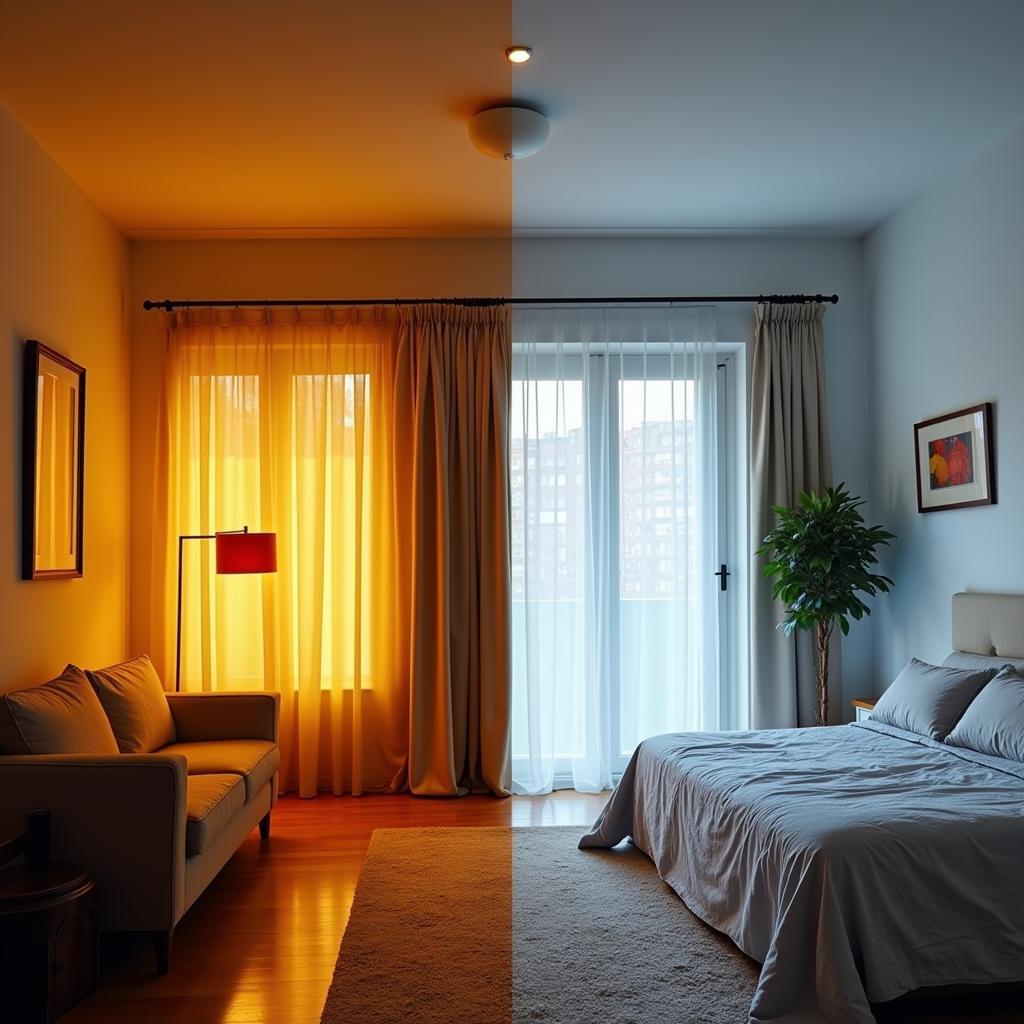Warm or cool light bulbs? This is a crucial question when designing the lighting for any space. Choosing between warm and cool light bulbs can drastically affect the mood and atmosphere, impacting everything from productivity to relaxation. Understanding the differences between these two types of light is essential to making the right choice for your home or workspace.
Understanding Color Temperature
The key difference between warm and cool light lies in their color temperature, measured in Kelvin (K). Lower Kelvin values (2700K-3000K) indicate warmer light, with a yellowish or reddish hue, similar to the light emitted by a traditional incandescent bulb or a sunset. Higher Kelvin values (3500K-6500K) represent cooler light, leaning towards blue or white, reminiscent of daylight or an overcast sky. Choosing the right color temperature is crucial for creating the desired ambiance and functionality in each room.
 Ánh sáng ấm áp và ánh sáng lạnh lẽo
Ánh sáng ấm áp và ánh sáng lạnh lẽo
Warm Light: Creating a Cozy and Inviting Atmosphere
Warm light bulbs are ideal for creating a relaxing and inviting atmosphere. The yellowish hue evokes feelings of warmth, comfort, and intimacy, making it perfect for living rooms, bedrooms, and dining areas. Warm light is also known to be more flattering to skin tones, enhancing the appearance of people and objects within the space.
Benefits of Warm Light
- Relaxing and comfortable: Ideal for spaces where you unwind and socialize.
- Flattering to skin tones: Creates a welcoming and pleasant atmosphere.
- Enhances the appearance of wood and warm-toned furnishings: Brings out the richness of these materials.
- Creates a sense of intimacy and coziness: Perfect for intimate gatherings and family time.
 Bóng đèn cho phòng khách và phòng ngủ
Bóng đèn cho phòng khách và phòng ngủ
Cool Light: Enhancing Focus and Productivity
Cool light bulbs, on the other hand, are more stimulating and promote alertness. The bluish-white hue mimics natural daylight, boosting energy levels and improving focus. This makes cool light a great choice for workspaces, kitchens, bathrooms, and areas where tasks requiring concentration are performed.
Benefits of Cool Light
- Increases alertness and focus: Beneficial for workspaces and study areas.
- Enhances visibility and detail: Makes tasks requiring precision easier.
- Creates a clean and modern look: Suits contemporary interiors.
- Mimics natural daylight: Helps regulate circadian rhythm.
Choosing the Right Light for Each Room
The choice between warm and cool light ultimately depends on the function and mood you want to create in a particular space. Here’s a quick guide:
- Living Room: Warm light creates a welcoming and relaxing atmosphere.
- Bedroom: Warm light promotes relaxation and sleep.
- Dining Room: Warm light fosters a cozy and intimate setting.
- Kitchen: Cool light enhances visibility for food preparation.
- Bathroom: Cool light provides bright illumination for grooming.
- Home Office/Study: Cool light promotes focus and productivity.
 Sử dụng ánh sáng cho từng phòng
Sử dụng ánh sáng cho từng phòng
Conclusion
Choosing between warm and cool light bulbs is a crucial decision that can significantly impact the ambiance and functionality of your space. By understanding the different color temperatures and their effects, you can create the perfect lighting scheme for every room in your home or workspace. Selecting the right light bulb is an investment in your comfort and well-being.
FAQ
-
What is the best light bulb color for reading? Warm light is generally recommended for casual reading, while cooler light might be better for focused studying.
-
Can I mix warm and cool light in the same room? Yes, layering different light sources with varying color temperatures can create a dynamic and balanced lighting scheme.
-
Are LED bulbs available in both warm and cool light? Yes, LED bulbs are available in a wide range of color temperatures, including both warm and cool options.
-
Which light color is better for energy efficiency? Both warm and cool LED bulbs are highly energy-efficient.
-
How do I know the color temperature of a light bulb? The Kelvin (K) value is usually printed on the bulb’s packaging.
-
Do different brands have different shades of warm and cool light? Yes, slight variations in color rendering can occur between different brands.
-
Can changing the light bulb color temperature affect my mood? Yes, lighting can have a significant impact on mood and well-being.
Mô tả các tình huống thường gặp câu hỏi.
Người dùng thường thắc mắc về việc lựa chọn loại bóng đèn phù hợp cho từng không gian cụ thể, ảnh hưởng của ánh sáng đến tâm trạng, và sự khác biệt giữa các loại bóng đèn trên thị trường.
Gợi ý các câu hỏi khác, bài viết khác có trong web.
Bạn có thể tìm hiểu thêm về các chủ đề liên quan như: “So sánh các loại bóng đèn LED”, “Thiết kế hệ thống chiếu sáng thông minh cho ngôi nhà”, “Ảnh hưởng của ánh sáng đến sức khỏe”.